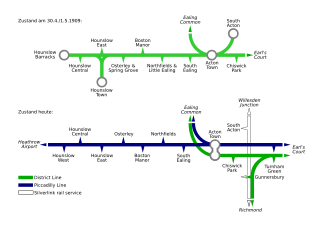
The ecliptic or ecliptic plane is the orbital plane of the Earth around the Sun. From the perspective of an observer on Earth, the Sun's movement around the celestial sphere over the course of a year traces out a path along the ecliptic against the background of stars. The ecliptic is an important reference plane and is the basis of the ecliptic coordinate system.

Navigation is a field of study that focuses on the process of monitoring and controlling the movement of a craft or vehicle from one place to another. The field of navigation includes four general categories: land navigation, marine navigation, aeronautic navigation, and space navigation.

A sextant is a doubly reflecting navigation instrument that measures the angular distance between two visible objects. The primary use of a sextant is to measure the angle between an astronomical object and the horizon for the purposes of celestial navigation.

The United States Naval Observatory (USNO) is a scientific and military facility that produces geopositioning, navigation and timekeeping data for the United States Navy and the United States Department of Defense. Established in 1830 as the Depot of Charts and Instruments, it is one of the oldest scientific agencies in the United States, and remains the country's leading authority for astronomical and timing data for all purposes.

The equatorial coordinate system is a celestial coordinate system widely used to specify the positions of celestial objects. It may be implemented in spherical or rectangular coordinates, both defined by an origin at the centre of Earth, a fundamental plane consisting of the projection of Earth's equator onto the celestial sphere, a primary direction towards the vernal equinox, and a right-handed convention.

The ecliptic coordinate system is a celestial coordinate system commonly used for representing the apparent positions, orbits, and pole orientations of Solar System objects. Because most planets and many small Solar System bodies have orbits with only slight inclinations to the ecliptic, using it as the fundamental plane is convenient. The system's origin can be the center of either the Sun or Earth, its primary direction is towards the vernal (March) equinox, and it has a right-hand convention. It may be implemented in spherical or rectangular coordinates.

In astronomy and celestial navigation, the hour angle is the angle between two planes: one containing Earth's axis and the zenith, and the other containing Earth's axis and a given point of interest.

Celestial navigation, also known as astronavigation, is the practice of position fixing using stars and other celestial bodies that enables a navigator to accurately determine their actual current physical position in space without having to rely solely on estimated positional calculations, commonly known as "dead reckoning", made in the absence of satellite navigation or other similar modern electronic or digital positioning means.
In astronomy and celestial navigation, an ephemeris is a book with tables that gives the trajectory of naturally occurring astronomical objects as well as artificial satellites in the sky, i.e., the position over time. Historically, positions were given as printed tables of values, given at regular intervals of date and time. The calculation of these tables was one of the first applications of mechanical computers. Modern ephemerides are often provided in electronic form. However, printed ephemerides are still produced, as they are useful when computational devices are not available.

A navigator is the person on board a ship or aircraft responsible for its navigation. The navigator's primary responsibility is to be aware of ship or aircraft position at all times. Responsibilities include planning the journey, advising the ship's captain or aircraft commander of estimated timing to destinations while en route, and ensuring hazards are avoided. The navigator is in charge of maintaining the aircraft or ship's nautical charts, nautical publications, and navigational equipment, and they generally have responsibility for meteorological equipment and communications. With the advent of satellite navigation, the effort required to accurately determine one's position has decreased by orders of magnitude, so the entire field has experienced a revolutionary transition since the 1990s with traditional navigation tasks, like performing celestial navigation, being used less frequently. Using multiple independent position fix methods without solely relying on electronic systems subject to failure helps the navigator detect errors. Professional mariners are still proficient in traditional piloting and celestial navigation.
Newcomb's Tables of the Sun is a work by the American astronomer and mathematician Simon Newcomb, published in volume VI of the serial publication Astronomical Papers Prepared for the Use of the American Ephemeris and Nautical Almanac. The work contains Newcomb's mathematical development of the position of the Earth in the Solar System, which is constructed from classical celestial mechanics as well as centuries of astronomical measurements. The bulk of the work, however, is a collection of tabulated precomputed values that provide the position of the sun at any point in time.

Longitude by chronometer is a method, in navigation, of determining longitude using a marine chronometer, which was developed by John Harrison during the first half of the eighteenth century. It is an astronomical method of calculating the longitude at which a position line, drawn from a sight by sextant of any celestial body, crosses the observer's assumed latitude. In order to calculate the position line, the time of the sight must be known so that the celestial position i.e. the Greenwich Hour Angle and Declination, of the observed celestial body is known. All that can be derived from a single sight is a single position line, which can be achieved at any time during daylight when both the sea horizon and the sun are visible. To achieve a fix, more than one celestial body and the sea horizon must be visible. This is usually only possible at dawn and dusk.

In celestial navigation, lunar distance is the angular distance between the Moon and another celestial body. The lunar distances method uses this angle, also called a lunar, and a nautical almanac to calculate Greenwich time if so desired, or by extension any other time. That calculated time can be used in solving a spherical triangle. The theory was first published by Johannes Werner in 1524, before the necessary almanacs had been published. A fuller method was published in 1763 and used until about 1850 when it was superseded by the marine chronometer. A similar method uses the positions of the Galilean moons of Jupiter.
The Astronomical Almanac is an almanac published by the United States Naval Observatory (USNO) and His Majesty's Nautical Almanac Office (HMNAO); it also includes data supplied by many scientists from around the world. It is considered a worldwide resource for fundamental astronomical data, often being the first publication to incorporate new International Astronomical Union resolutions. The almanac largely contains Solar System ephemeris and catalogs of selected stellar and extragalactic objects. The material appears in sections, each section addressing a specific astronomical category. The book also includes references to the material, explanations, and examples. It is available one year in advance of its date.
Jet Propulsion Laboratory Development Ephemeris designates one of a series of mathematical models of the Solar System produced at the Jet Propulsion Laboratory in Pasadena, California, for use in spacecraft navigation and astronomy. The models consist of numeric representations of positions, velocities and accelerations of major Solar System bodies, tabulated at equally spaced intervals of time, covering a specified span of years. Barycentric rectangular coordinates of the Sun, eight major planets and Pluto, and geocentric coordinates of the Moon are tabulated.
The Nautical Almanac has been the familiar name for a series of official British almanacs published under various titles since the first issue of The Nautical Almanac and Astronomical Ephemeris, for 1767: this was the first nautical almanac to contain data dedicated to the convenient determination of longitude at sea. It was originally published from the Royal Greenwich Observatory in England. A detailed account of how the publication was produced in its earliest years has been published by the National Maritime Museum.

The navigational algorithms are the quintessence of the executable software on portable calculators or PDA as an aid to the art of navigation, this attempt article describe both algorithms and software for "PC-PDA" implementing different calculation procedures for navigation . The calculation power obtained by the languages: Basic, "C", Java, etc. .., from portable calculators or PDAs, has made it possible to develop programs that allow calculating the position without the need for tables, in fact they have some basic tables with the correction factors for each year and calculate the values "on the fly" at runtime.
A fundamental ephemeris of the Solar System is a model of the objects of the system in space, with all of their positions and motions accurately represented. It is intended to be a high-precision primary reference for prediction and observation of those positions and motions, and which provides a basis for further refinement of the model. It is generally not intended to cover the entire life of the Solar System; usually a short-duration time span, perhaps a few centuries, is represented to high accuracy. Some long ephemerides cover several millennia to medium accuracy.
Donald Harry Sadler (1908–1987) was an English astronomer and mathematician who developed an international reputation for his work in preparing astronomical and navigational almanacs. He worked as the Superintendent of His Majesty's Nautical Almanac Office from 1937 to 1971.














